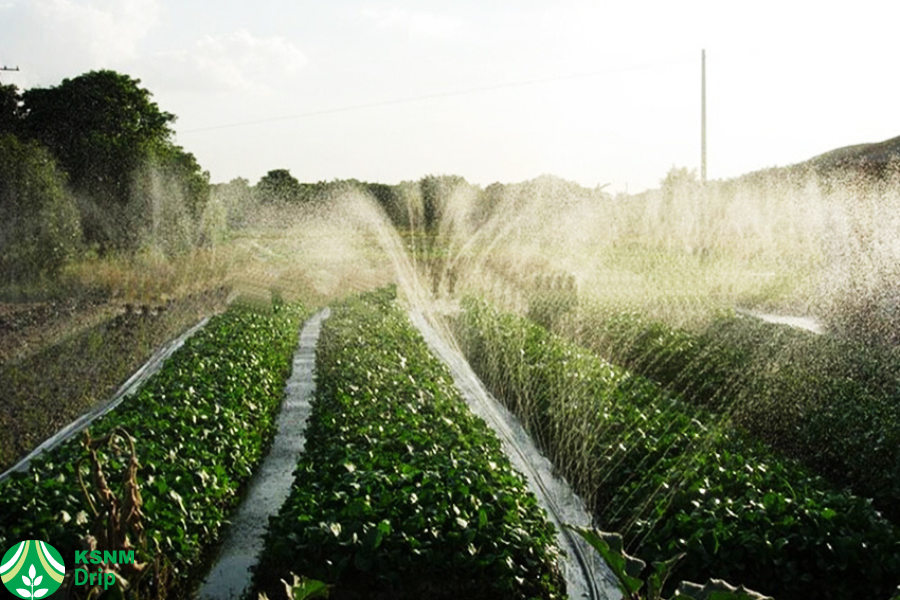Posted On: July 16, 2024
Posted By: KSNM DRIP

The Rain Hose Irrigation System is a revolutionary approach in greenhouse farming, designed to mimic natural rainfall through a network of hoses with tiny perforations. This system is particularly crucial in greenhouses where precise water management can significantly affect plant health and productivity. By adopting rain hose irrigation, farmers can achieve better water distribution, conserve resources, and improve crop yields.
Yes, a rain hose irrigation system can be used effectively in a greenhouse. These systems provide a cost-effective, efficient, and environmentally friendly way to water plants uniformly, which is crucial for the optimal growth of various crops. By simulating natural rainfall, rain hose irrigation systems ensure that plants receive the right amount of water, enhancing their growth and productivity.
A greenhouse is a structure designed for growing plants in a controlled environment. It consists of transparent walls and roofing materials, typically made of glass or plastic, that allow sunlight to enter while trapping heat inside. This creates a warm and humid environment conducive to plant growth, even in colder climates or during unfavourable weather conditions. And rain hose irrigation systems can help greenhouses control their environment for the better growth of crops.
Rain hose systems deliver water evenly across the greenhouse, ensuring each plant receives the right amount of moisture. This uniform distribution helps prevent overwatering or underwatering, promoting healthier plant growth and maximizing crop yield.
These systems are designed to minimize water wastage by delivering a fine mist that mimics natural rainfall. Compared to traditional irrigation methods, rain hose irrigation reduces water runoff and evaporation, leading to more efficient water usage and lower water bills.
Once installed, rain hose systems require minimal manual intervention, saving time and labour costs for greenhouse operators. With automated watering schedules and consistent moisture levels, growers can focus on other essential tasks such as crop monitoring and maintenance.
While the initial investment in rain hose irrigation may be higher than traditional watering systems, the long-term benefits outweigh the costs. Reduced water consumption, lower labour requirements, and improved crop productivity contribute to overall cost savings for greenhouse operations.
By providing plants with consistent moisture and nutrients, rain hose irrigation promotes robust growth and development. Plants are less susceptible to stress, diseases, and nutrient deficiencies, resulting in higher-quality crops with better market value.
Tomatoes thrive in greenhouse environments due to their need for consistent moisture and warmth. Rain hose irrigation ensures uniform watering, promoting healthy growth and high-quality fruit production.
Cucumbers benefit from the controlled conditions of a greenhouse, where rain hose irrigation provides adequate moisture without waterlogging the soil. This results in better fruit development and reduced disease risk.
Leafy greens like lettuce grow exceptionally well in greenhouses with rain hose irrigation. The even distribution of water helps maintain optimal soil moisture levels, preventing wilting and ensuring continuous harvests.
Peppers require warm temperatures and consistent watering to produce abundant fruit. Greenhouse cultivation with rain hose irrigation provides the ideal conditions for pepper plants, resulting in higher yields and quality produce.
Herbs such as basil, cilantro, and parsley thrive in greenhouse environments where moisture levels are carefully controlled. Rain hose irrigation ensures that herbs receive the right amount of water, promoting vigorous growth and flavour development.
Many flower varieties, including roses, gerberas, and carnations, flourish in greenhouses with rain hose irrigation. The precise watering system encourages strong root development and vibrant blooms, making them ideal for commercial flower production.
Begin by planning the layout of the irrigation system, taking into account the size and shape of the greenhouse, as well as the location of plants. Ensure that the system covers the entire growing area effectively.
Purchase the necessary materials for the irrigation system, including rain hoses, connectors, fittings, nozzles or emitters, pressure regulators, and main hoses. Choose high-quality components that are durable and suitable for greenhouse use.
Clear the greenhouse of any debris or obstacles that may interfere with the installation process. Level the ground if necessary to ensure proper water distribution.
Unroll the main hose along the length of the greenhouse, positioning it in a central location for optimal water distribution. Secure the hose in place using stakes or anchors to prevent movement.
Use connectors and fittings to join sections of the main hose together, creating a continuous water distribution line. Ensure that connections are secure to prevent leaks.
Attach nozzles or emitters to the main hose at regular intervals, following the manufacturer's instructions for spacing and placement. These components regulate water flow and direction, ensuring even distribution across the greenhouse.
Install pressure regulators at key points in the system to maintain consistent water pressure throughout. This helps prevent fluctuations that can affect watering accuracy.
Once the installation is complete, test the irrigation system to ensure that it is functioning correctly. Turn on the water supply and inspect for leaks, adjusting pressure regulators as needed to achieve the desired flow rate.
Make any necessary adjustments to the layout or component placement to optimize water distribution. Check for areas with inadequate coverage and add additional hoses or emitters as needed.
After installation, perform regular maintenance on the rain irrigation system to keep it in good working condition. Check for clogs or damage to hoses and nozzles, and replace any worn components as necessary.
Rain hose irrigation systems offer numerous advantages for greenhouse cultivation, including uniform water distribution, water conservation, labour efficiency, cost-effectiveness, and healthy plant growth. By installing and maintaining these systems properly, greenhouse operators can optimize crop yields, reduce water usage, and enhance overall productivity. With the ability to cultivate a variety of crops efficiently, rain hose irrigation contributes to sustainable and profitable greenhouse farming practices.